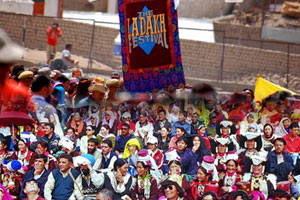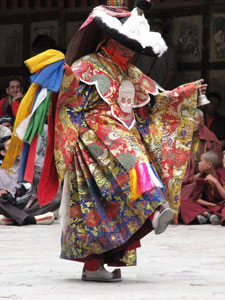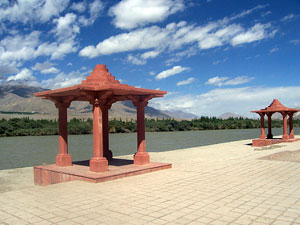|
|
|
Ladakh Festivals |
|
|
|
Festivals in Ladakh
are celebrated as the occasions for merry-making. These
festivals provide people with various opportunities to
interact with each other, form new ties and renew the
old ones. Many of the annual festivals of the Gompas in
Ladakh takes place in winter, which is a relatively idle
time for majority of the people. It is time when the
whole village gather together. Stalls are erected and
goods of daily need and enjoyment are sold. Eatables are
|
 |
|
|
brought along and families
and relatives would enjoy the meals
together. The whole activity takes place around the gompas. In
the courtyards of the Gompas, colourful masked dances and
dance-dramas are performed. Lamas, dressed in colourful robes
and wearing startlingly frightful masks, perform mimes
symbolizing various aspects of the religion such as the
progress of the individual soul and its purification or the
triumph of good over evil. Local people flock from near and
far to these events and the spiritual benefits they get are no
doubt heightened by their enjoyment of the party atmosphere.
This is also an occasion to demonstrate the cultural heritage
as well as the wealth of that particular monastery. Big and
rare musical instruments, old weapons and religious objects
including Thangkas are brought out during the performances.
The first ceremony of any festival is very interesting as the
male Lama is accompanied by the monks. Musicians, dancers and
singers in an harmony create for visitors an unforgettable
experience. Some of the popular themes includes the victory of
good over evil or some special stories related to great Lamas
where their supernatural power is demonstrated or the stories
related to Guru Padmasambhava. Their dances are also very
colourful. A clown plays an important role so that the
villagers do not get disinterested by an overdose of religion
or history so that atmosphere is joyful. Spituk, Stok, Thikse,
Chemrey and Matho have their festivals in winter, between
November and March. There are some festivals which are
celebrated in warmer months. These are Lamayuru Festival
(April or May), Phyang Festival, Thikse Festival (July or
August). Some other festivals celebrated in Ladakh are as
follows: |
|
|
|
Hemis
Festival in Ladakh
Hemis is the biggest and most famous of the monastic
festivals, frequented by tourists and local alike. Hemis
Festival is celebrated in the end of June or in early
July and is dedicated to Guru Padmasambhava. After every
12 years, the Gompa's greatest treasure, a huge thangka
or a religious icon painted or embroidered on cloth is
ritually exhibited. The next unveiling is due to take
place in 2004 AD.
Dosmoche Festival
in Ladakh
Dosmoche Festival, the festival of the scapegoat, is
celebrated with great enthusiasm at Leh. Dosmoche
Festival falls in the second half of February. Dosmoche
is one of two New Year festivals, the other being Losar.
At Dosmoche, a great wooden mast decorated with
streamers and religious emblems is held up outside Leh.
|
 |
|
|
At the appointed time,
offerings of storma, ritual figures moulded out of dough, are
brought out and ceremonially cast away into the desert, or
burnt. These scapegoats carry away with them the evil spirits
of the old year, and thus the town is cleansed and made ready
to welcome the new year. Likir and Deskit (Nubra) also time
their festivals to coincide with Dosmoche festival.
Losar Festival in Ladakh
Losar, the spectacular festival celebrates the Ladakhi or
Tibetan new year. The festivities last for 2 weeks during
December or January, depending on the Lunar Calendar. All
Ladakhi Buddhists celebrate it by making offerings to the
gods, both in Gompas and in their domestic shrines. The
festival is marked with ancient rituals, the stage fights
between good and evil, chanting and passing through the crowds
with fire torches, the dance of the Ibex deer and the dramatic
battles between the King and his ministers. This festival is
full of music, dances and merry-making. This important
festival changes its location and dates every year.
|
|
|
|
Phyang
Festival in Ladakh
Phyang Festival is celebrated in the month of July (late
July or early August) in Ladakh. Like Hemis, the Phyang
festival also involves the exhibition of gigantic
Thangka, though here it is done every year.
Ladakh Harvest
Festival in Ladakh
The festival usually starts from 1st September and lasts
till September 15th. It is a colourful celebration of
the rich, cultural |
 |
|
|
diversity of Ladakh's
people. The weeks long festivities are held all over the
region. Music, theatre, polo, archery and wedding ceremonies
are performed daily along with mask and folk dances, with the
final carnival parade passing through the streets of Leh.
Ladakh Festival in Ladakh
The Ladakh festival is conducted for 15 days i.e. from the 1st
to the 15th of September in Ladakh. Various sports such as
polo and archery, folk dances and songs, age-old social and
cultural ceremonies, art and handicrafts, all come alive in a
colorful kaleidoscope.
Tak-Tok Festival in Ladakh
Tak-Tok festival is celebrated at cave Gompa of Tak-Tok in
Ladakh. It is one of the major festivals of Ladakh. Tak-Tok
festival is celebrated for about ten days after Phyang
festival. This festival is celebrated in summer, and yet
another tourist attraction. The festival is celebrated with
fanfare and locals from far areas storm the place on the
occasion. |
|
|
|
Sindhu Darshan
Festival in Ladakh
Sindhu Darshan Festival, as the name suggests, is a
celebration of the Sindhu river. The people travel here
for the Darshan and Puja of the River Sindhu (Indus)
which originates from the Mansarovar in Tibet. The
festival aims at projecting the Sindhu river as a symbol
of multi-dimensional cultural identity, communal harmony
and peaceful co-existence in India. This festival is
also a symbolic salute to the brave soldiers of India
who have valiantly fought the odds at |
 |
|
|
Siachen, Kargil and other
places. It is also an opportunity for people from around the
country and overseas to visit the beautiful regions of Leh and
Ladakh. This festival was first celebrated in the year 1997
and later this festival is organized annually at Leh in the
month of May-June by the Government of Jammu and Kashmir with
the support of the Ministry of tourism and culture, Government
of India. The festival is kaleidoscope of Indian culture and
showcases an exciting array of performing arts being brought
together at an exciting place. As part of the celebrations,
various groups from different states in India bring water from
the other mighty rivers in the country in earthen pots and
immerse these pots in the Sindhu river, thereby mingling the
river water with other waters of the land. |
|